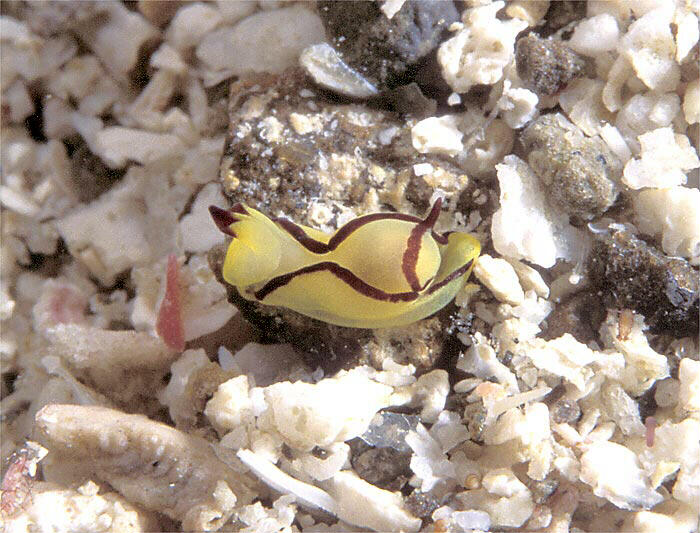 |
Siphopteron brunneomarginatum
Photo courtesy of Jeff RosenfeldIt amazes me when divers like Jeff find these very tiny, yet beautiful species. I guess his youthful eyesight is the answer. Siphopteron brunneomarginatum is indeed small, measuring up to only about 4 mm in length. The body is uniformly yellow and has a brown marginal band, from which the name is derived. This species also has brown on the on the tip of the siphon, the flagellum and across the visceral hump near the posterior end of the animal. The parapodia come together dorso-medially and often overlap.
A similarly colored species often confused with Siphopteron brunneomarginatum is Siphopteron nigromarginatum Gosliner, 1989 . This latter species has a very thin marginal line compared to the wide marginal band in S. brunneomarginatum and the parapodia remain spread part and never overlap. Some specimens of Siphopteron nigromarginatum are less uniform in color and may have orange mottling on the head shield and visceral hump. It is a slightly larger species reaching an eye squinting 10 mm.
An excellent lateral shot of this neat little species can be found in Atsushi Ono's guide on page 20. Little is known about the biology of these species, but muscular movement of the parapodia can provide the ability to swim and flee inquisitive predators.
By coincidence, Siphopteron brunneomarginatum was featured as the slug of the week on Bob Bolland's Okinawa Slug Site a week before presentation on this site!
Danville, Calif
Jun., 2002
WEBMASTER'S NOTE: Myself and Jerry Allen shared the pleasure of having Atsushi Ono as our guide on a recent trip to the Kerama Islands, Okinawa, Japan. We were fortunate to see and photograph a number of Siphopteron brunneomarginatum specimens thanks to Ono-san's skill in finding the animals. In the upcoming weeks, a number of BOW's will be presented recounting our experiences on this memorable trip!

|
By vocation, Jeff Rosenfeld is the Technology Coordinator for a high school in Seattle, Washington. In his spare time, he loves to travel. Jeff began diving in 1994 and taking underwater photos in 1995. Among his favorite destinations are the Philippines, Solomon Islands, Indonesia, and a bit closer to home, Vancouver Island. Jeff maintains a web site of his underwater photography called The Vibrant Sea . Jeff has the following to say about the locality of this Nudibranch of the Week. "...Few places in the world better demonstrate the ocean's truly amazing ability to withstand man's best efforts to destroy it better than Anilao, Philippines. Located a mere 3 hour drive south of Manila, Anilao represents to me, better than any other location I've visited, the potential humans have on the sea. In Anilao, marine identification books are only of so much use as one constantly comes into contact with creatures that simply have not yet been discovered or in the least, formally named. Even though hundreds of thousands, if not millions, of divers have visited these waters, scientists still constantly identify new species on Anilao's reefs. When it comes to sheer diversity of macro creatures, I've simply never encountered any single location quite like Anilao. From the truly bizarre that one can find nightly at a dive site like Basura to the pristine beauty of a reef such as Beatrice, Anilao simply offers mind-blowing macro diversity..."
|
Taxonomic information courtesy of:

David W. Behrens
Author:
Pacific Coast Nudibranchs
Send Dave mail at seachalleng@earthlink.net
|
